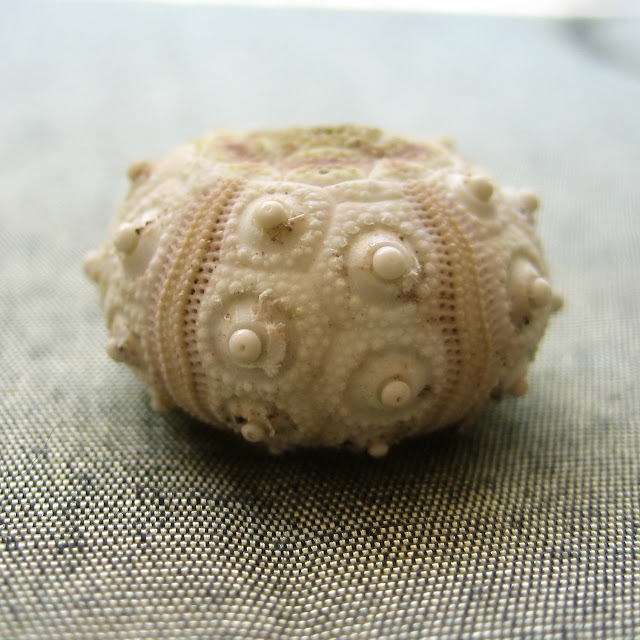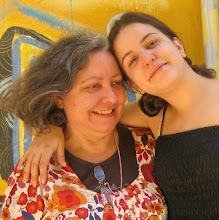
It took me a long time to find a way to take decent pictures. Not only the correct light, but also background and position of camera and item. It still happens often that some pieces are harder to capture as they are then others. It always stays difficult to show the piece truly as it is and give it justice.
First I started with a white background, but I found it very difficult to keep the white truly white and not grey or blue plus I was not familiar yet with photoshop or how to position the camera or piece. Uhhh looks horrible...

I always take at least 15 shots of a piece, as there will always be some out of focus or just has not 'it'.
The 'it' part is hard to explain, it is something that you see as soon as you see the picture. It has sensation, deepness and drives your attention as soon as you see the picture.

After (trying) to sell on Rubylane for almost a year and (trying) to sell on Etsy for six months and experiment with other colors as background. I found the grey background I use now the best. As we are with this together, my mum and I, and we both design in a different style the shop needed something calm so that it wouldn't become a messy color mix soup. The grey is warmer then white but does not take the colors away from the items and makes a good basic background.
As I didn't (and still hardly can) manage Adobe Photoshop, I started to use ACDSee and found it quite easy to manage pictures there. Of course you need good pictures as basic, but without the managing it will not 'pop' as it should. Here are the steps I go through with pictures, for our shops and blog. I take the pictures at early afternoon, when the sun is shining, but in the shadow.
Natural light is simply the best. I manage the light manual on my camera and make it +3/4 lighter (+/- Comp.) and of course on Macro setting.
This is the 'untouched' picture:


First thing is to crop it, usually, if I can, I make it square but keep in mind the Gallery mode of Etsy to keep some space at the top and bottom from the object.


Then I add Shadow/Highlights. This makes the picture not only sharper but also more 'real', touchable plus gives deepness.

Then at 'Colors', I change the Saturation, of course looking at the real object to avoid that the colors do not become as they are not in real. You have to be sure that the colors you show are truly the real colors. As you can see, the differences are very small, and look not worthy the work, but they really make a difference and each picture takes about maximum 1 minute of my time.

Finally I remove the distracting flaws of the background with Photo repair and with this picture I also cleaned the urchin a bit. Of course the cleaning job is very useful, sometimes it happens that a tiny tiny dust piece is on the piece that you can only see in the pictures but not in real. Removing a tiny dust and distracting background flaws makes the picture neat and complete.
Here another example, this time a jewelry piece, again the same steps except the photo repair. Tiny changes make a difference.




Hope this information can help others who struggle with pictures, and if I can do this everyone can, I'm sooo not technical!!




Hope this information can help others who struggle with pictures, and if I can do this everyone can, I'm sooo not technical!!





























Very clear and concise. Thanks!
ReplyDeletelooks brilliant Star!
ReplyDeleteNever heard ACDSee before, have to google that...
Very interesting - thanks! I still have tons to learn about taking pictures - i just take them, crop them and list them :)
ReplyDeleteThank you, star.. very clear tutorial! I have such a lot to learn about taking good pictures...never heard about ACDSee before.
ReplyDeleteVery well done! :)
ReplyDeleteGreat article Star i am sure it will help a lot of people!
ReplyDeleteThanx for taking the time to do this :)
I use Picasa but I'll look into ACDSee - that photo repair tool sounds cool! Thanks for sharing - great blogpost! :)
ReplyDeleteWow, this was such a great post and will hopefully help others to learn to edit as nicely as you do!
ReplyDeleteGreat tutorial, Star!
ReplyDeleteWell done:) As you say, it's not much, but the difference is that the final pic makes you want to look at the item a bit further!
ReplyDeletei'm with you on the grey background thing, I've stopped doing them on white, it's a bit too "catalog" like :)
interesting post - I think most of the issues that people have with their stores on etsy is the photography! I know that I found something that works for me, but am trying to sell all the pieces that were taken on different backgrounds before hah. Good luck, you have great pieces :)
ReplyDeleteYou have already help me allot with my pictures and this is a great reminder!
ReplyDeletethank you for sharering!
Wow, thanks for that!
ReplyDeleteMelissa
Hi,
ReplyDeleteInteresting to see the steps you go through with your photos. I always think the photos in your shop look really great and make the items very appealing.
Well done, stars... I am constantly struggling with the photos, Northern days are usually too dark to make them...
ReplyDeletePictures are the thing I dread the most. Your pictures have always been excellant, some of the best on Etsy!
ReplyDeleteGreat Star!
ReplyDeleteVery clear.Now I have to study my camera...
:) really useful and simple step-by-step tutorial indeed... but that is very true, to find style to "calm" diverse style of items quite a challenge...
ReplyDeleteFantastic! Thanks Star!! :)
ReplyDeleteIt is so generous of you to share this tutorial with everyone! Thanks, star.
ReplyDeleteThank you so much for these tips Star! Very useful and extremely helpful. Your photos are always so wow, this article is greatly appreciated :)
ReplyDeleteThank you for sharing your tips. I struggle with my pics too. And i don't have much daylight during autumn-winter. From november till mid January, it's about 4-5 hours only. I have a weekend, so aguess, i'll just have to take the most of it :)
ReplyDeleteThanks again :)
Thanks, I will go and try taking photos on a grey background now :)
ReplyDelete